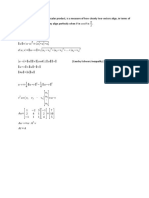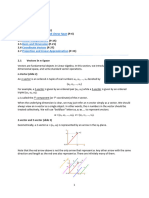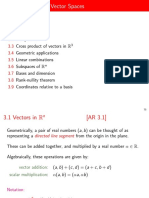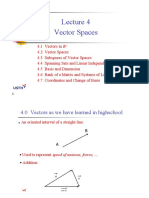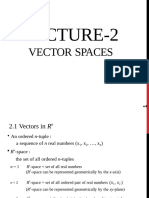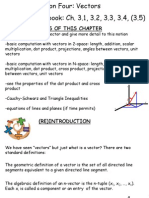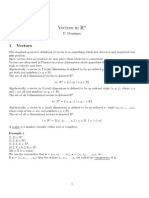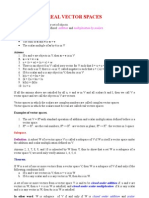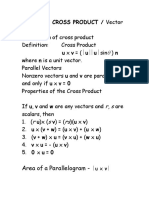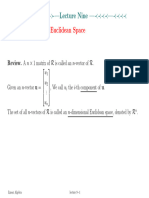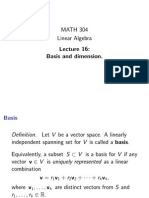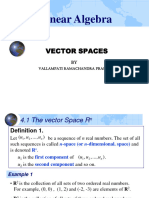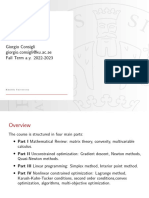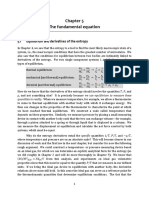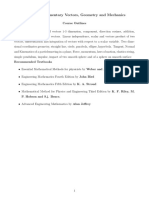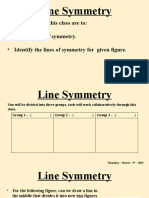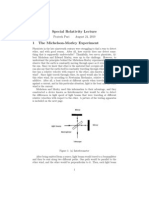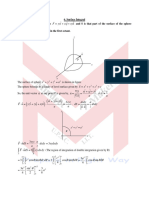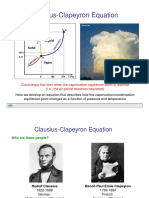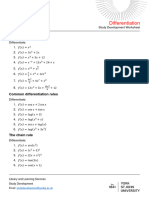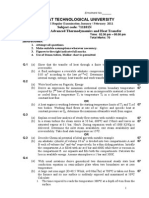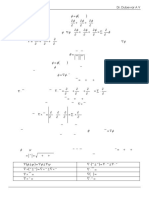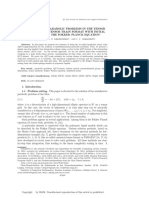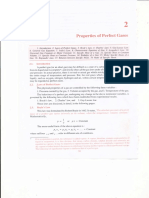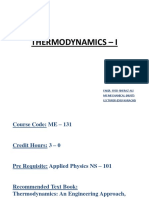0 ratings0% found this document useful (0 votes)
3 viewsNotes From Anton 10 TH Ed CH 3
Notes From Anton 10 TH Ed CH 3
Uploaded by
Erimias EshetuLinear algebra pdf
Copyright:
© All Rights Reserved
Available Formats
Download as PDF, TXT or read online from Scribd
Notes From Anton 10 TH Ed CH 3
Notes From Anton 10 TH Ed CH 3
Uploaded by
Erimias Eshetu0 ratings0% found this document useful (0 votes)
3 views3 pagesLinear algebra pdf
Original Title
NotesFromAnton10thEdCh3
Copyright
© © All Rights Reserved
Available Formats
PDF, TXT or read online from Scribd
Share this document
Did you find this document useful?
Is this content inappropriate?
Linear algebra pdf
Copyright:
© All Rights Reserved
Available Formats
Download as PDF, TXT or read online from Scribd
Download as pdf or txt
0 ratings0% found this document useful (0 votes)
3 views3 pagesNotes From Anton 10 TH Ed CH 3
Notes From Anton 10 TH Ed CH 3
Uploaded by
Erimias EshetuLinear algebra pdf
Copyright:
© All Rights Reserved
Available Formats
Download as PDF, TXT or read online from Scribd
Download as pdf or txt
You are on page 1of 3
NOTES FROM ELEMENTARY LINEAR ALGEBRA, 10TH EDITION, BY ANTON AND RORRES
CHAPTER 3: EUCLIDEAN VECTOR SPACES
!
Section 3.1: Vectors in 2-Space, 3-Space, and n-Space
Definition. If n is a positive integer, then an ordered n-tuple is a sequence of n real numbers (a1, a2, … , an). The set of all ordered
n-tuples is called n-space and is denoted by Rn.
Definition. Two vectors v = (v1, v2, … , vn) and w = (w1, w2, … , wn) in Rn are said to be equivalent (also equal) if v1 = w1, v2 = w2,
… , vn = wn. We indicate this by writing v = w.
Definition. If v = (v1, v2, … , vn) and w = (w1, w2, … , wn) are vectors in Rn, and if k is any scalar, then we define v + w = (v1 + w1, v2
+ w2, … , vn + wn); kv = (kv1, kv2, … , kvn); –v = (–v1, –v2, … , –vn); w – v = w + (–v) = (w1 – v1, w2 – v2, … , wn – vn)
Theorem. If u, v, and w are vectors in Rn, and if k and m are scalars, then:
(a) u + v = v + u
(b) u + (v + w) = (u + v) + w
(c) u + 0 = 0 + u = u
(d) u + (–u) = 0
(e) k(u + v) = ku + kv
(f)(k + m)u = ku + mu
(g) k(mu) = (km)u
(h) 1u = u
Theorem. If v is a vector in Rn and k is a scalar, then:
(a) 0v = 0
(b) k0 = 0
(c) (–1)v = –v
Definition. If w is a vector in Rn, then w is said to be a linear combination of the vectors v1, v2, … , vr in Rn if it can be expressed in
the form w = k1v1 + k2v2 + … + krvr where k1, k2, … , kr are scalars. These scalars are called the coefficients of the linear
combination. In the case where r = 1, w = k1v1, so that a linear combination of a single vector is just a scalar multiple of
that vector.
!
Section 3.2: Norm, Dot Product, and Distance in Rn
Definition. If v = (v1, v2, … , vn) is a vector in Rn, then the norm of v (also called the length of v or the magnitude of v) is denoted
by ||v||, and is defined by the formula ||v|| = √(v12 + v22 + v32 + … + vn2)
Theorem. If v is a vector in Rn, and if k is any scalar, then: ||v|| ≥ 0, ||v|| = 0 if and only if v = 0, ||kv|| = |k| ||v||
• unit vector u = (1/||v||)v
• v = (v1, v2, … , vn) = v1e1 + v2e2 + … + vnen
Definition. If u = (u1, u2, … , un) and v = (v1, v2, … , vn) are points in Rn, then we denote the distance between u and v by d(u,v) and
define it to be d(u,v) = ||u – v|| = √[(u1 – v1)2 + (u2 – v2)2 + … + (un – vn)2]
Definition. If u and v are nonzero vectors in R2 or R3, and if θ is the angle between u and v, then the dot product (also called the
Euclidean inner product) of u and v is denoted by u•v and is defined as u•v = ||u|| ||v|| cos θ. If u = 0 or v = 0, then we
define u•v to be 0.
Definition. If u = (u1, u2, … , un) and v = (v1, v2, … , vn) are any vectors in Rn, then the dot product (also called the Euclidean inner
product) of u and v is denoted by u•v is defined by u•v = u1v1 + u2v2 + … + unvn
• ||v|| = √(v•v)
Theorem. If u, v, and w are vectors in Rn, and if k is a scalar, then:
(a) u•v = v•u (symmetry property)
(b) u•(v+w) = u•v + u•w (distributive property)
(c) k(u•v) = (ku)•v (homogeneity property)
(d) v•v ≥ 0 and v•v = 0 if and only if v = 0 (positivity property)
Theorem. If u, v, and w are vectors in Rn, and if k is a scalar, then:
(a) 0•v = v•0 = 0
(b) (u+v)•w = u•w + v•w
(c) u•(v–w) = u•v – u•w
(d) (u–v)•w = u•w – v•w
(e) k(u•v) = u•(kv)
• θ = cos–1[(u•v)/(||u|| ||v||)]
Theorem. Cauchy-Schwarz Inequality: If u = (u1, u2, … , un) and v = (v1, v2, … , vn) are vectors in Rn, then: |u•v| ≤ ||u|| ||v||
Theorem. If u, v, and w are vectors in Rn, then: ||u+v|| ≤ ||u|| + ||v|| (Triangle Inequality for Vectors) and d(u,v) ≤ d(u,w) + d(w,v)
(Triangle Inequality for Distances)
Theorem. Parallelogram Equation for Vectors: If u and v are vectors in Rn, then: ||u + v||2 + ||u – v||2 = 2(||u||2 + ||v||2)
Theorem. If u and v are vectors in Rn with the Euclidean inner product, then u•v = ¼||u + v||2 – ¼||u – v||2
• u•v = vTu
• Au•v = u•ATv
• u•Av = ATu•v
!
Section 3.3: Orthogonality
Definition. Two nonzero vectors u and v in Rn are said to be orthogonal (or perpendicular) if u•v = 0. We will also agree that the
zero vector in Rn is orthogonal to every vector in Rn. A nonempty set of vectors in Rn is called an orthogonal set if all
pairs of distinct vectors in the set are orthogonal. An orthogonal set of unit vectors is called an orthonormal set.
• Point-Normal Form of the Equation of a Line for P0(x0,y0) and n = (a,b): a(x – x0) + b(y – y0) = 0
• Point-Normal Form of the Equation of a Plane for P0(x0,y0,z0) and n = (a,b,c): a(x – x0) + b(y – y0) + c(z – z0) = 0
Theorem. (a) If a and b are constants that are not both zero, then an equation of the form ax + by + c = 0 represents a line in R2 with
normal n = (a,b).
(b) If a, b, and c are constants that are not all zero, then an equation of the form ax + by + cz + d = 0 represents a plane in
R3 with normal n = (a,b,c).
• n•x = 0
Theorem. Projection Theorem: If u and a are vectors in Rn, and if a ≠ 0, then u can be expressed in exactly one way in the form u
= w1 + w2, where w1 is a scalar multiple of a and w2 is orthogonal to a.
• projau = (u•a/||a||2)a (vector component of u along a)
• u – projau = u –(u•a/||a||2)a (vector component of u orthogonal to a)
• ||projau|| = |u•a|/||a|| = ||u|| |cos θ| where θ is the angle between u and a.
Theorem. Theorem of Pythagoras in Rn: If u and v are orthogonal vectors in Rn with the Euclidean inner product, then ||u + v||2 =
||u||2 + ||v||2
Theorem. (a) In R2, the distance between the point P0(x0, y0) and the line ax +by + c = 0 is D = |ax0 +by0 + c|/√(a2 + b2)
(b) In R3, the distance between the point P0(x0, y0, z0) and the plane ax +by + cz + d = 0 is
D = |ax0 +by0 + cz0 + d|/√(a2 + b2 + c2)
!
Section 3.4: The Geometry of Linear Systems
Theorem. Let L be the line in R2 or R3 that contains the point x0 and is parallel to the nonzero vector v. Then the equation of the
line through x0 that is parallel to v is x = x0 + tv. If x0 = 0, then the line passes through the origin and the equation has
the form x = tv.
Theorem. Let W be the plane in R3 that contains the point x0 and is parallel to the noncollinear vectors v1 and v2. Then an equation
of the plane through x0 that is parallel to v1 and v2 is given by x = x0 + t1v1 + t2v2. If x0 = 0, then the plane passes
through the origin and the equation has the form x = t1v1 + t2v2.
Definition. If x0 and v are vectors in Rn, and if v is nonzero, then the equation x = x0 + tv defines the line through x0 that is parallel
to v. In the special case that x0 = 0, the line is said to pass through the origin.
Definition. If x0, v1, and v2 are vectors in Rn, and if v1 and v2 are not collinear, then the equation x = x0 + t1v1 + t2v2 defines the plane
through x0 that is parallel to v1 and v2. In the special case that x0 = 0, the line is said to pass through the origin.
Definition. If x0 and x1 are vectors in Rn, then the equation x = x0 + t(x1 – x0), (0 ≤ t ≤ 1), defines the line segment from x0 to x1.
When convenient, this equation can be written as x = (1 – t)x0 + tx1, (0 ≤ t ≤ 1).
Theorem. If A is an m × n matrix, then the solution set of the homogeneous linear system Ax = 0 consists of all vectors in Rn that
are orthogonal to every row vector of A.
Theorem. The general solution of a consistent linear system Ax = b can be obtained by adding any specific solution of Ax = b to
the general solution of Ax = 0.
!
Section 3.5: Cross Product
Definition. If u = (u1, u2, u3) and v = (v1, v2, v3) are vectors in 3-space, then the cross product u × v is the vector defined by u × v =
(u2v3 – u3v2, u3v1 – u1v3, u1v2 – u2v1).
Theorem. Relationships Involving Cross Product and Dot Product: If u, v, and w are vectors in 3-space, then:
(a) u•(u×v) = 0 (u×v is orthogonal to u)
(b) v•(u×v) = 0 (u×v is orthogonal to v)
(c) ||u×v||2 = ||u||2||v||2 – (u•v)2 (Lagrange’s Identity)
(d) u×(v×w) = (u•w)v – (u•v)w (relationship between cross and dot products)
(e) (u×v)×w = (u•w)v – (v•w)u (relationship between cross and dot products)
Theorem. Properties of Cross Product: If u, v, and w are any vectors in 3-space and k is any scalar, then:
(a) u×v = –(v×u)
(b) u×(v+w) = (u×v) + (u×w)
(c) (u+v)×w = (u×w) + (v×w)
(d) k(u×v) = (ku)×v = u×(kv)
(e) u×0 = 0×u = 0
(f) u×u = 0
Theorem. Area of a Parallelogram: If u and v are vectors in 3-space, then ||u × v|| = ||u|| ||v|| sin θ is equal to the area of the
parallelogram determined by u and v.
|u1 u2 u3|
|v1 v2 v3|
Definition. If u, v, and w are vectors in 3-space, then u•(v×w) = |w ' 1 w2 w3| is called the scalar triple product of u, v, and w.
⎡u1 u2⎤
Theorem. (a) The absolute value of the determinant det ⎣v ' 1 v2⎦ is equal to the area of the parallelogram in 2-space determined
by the vectors u = (u1, u2) and v = (v1, v2).
⎡u1 u2 u3⎤
⎢v1 v2 v3⎥
(b) The absolute value of the determinant det ⎣w ' 1 w2 w3⎦ is equal to the volume of the parallelepiped in 3-space
determined by the vectors u = (u1, u2, u3), v = (v1, v2, v3), and w = (w1, w2, w3).
Theorem. If the vectors u = (u1, u2, u3), v = (v1, v2, v3), and w = (w1, w2, w3) have the same initial point, then they lie in the same plane
if and only if u•(v×w) = 0.
You might also like
- Bab 3 Vectors r2 r3 PDFDocument41 pagesBab 3 Vectors r2 r3 PDFLailatul MaghfirohNo ratings yet
- Kunci-Jawaban Howard AntonDocument41 pagesKunci-Jawaban Howard AntonAlyagariniNo ratings yet
- LinAlg NotesDocument7 pagesLinAlg NotesNathan DysonNo ratings yet
- Chapter 5. General Vector SpacesDocument131 pagesChapter 5. General Vector Spacestungduong0708No ratings yet
- Notes Mich14 PDFDocument97 pagesNotes Mich14 PDFCristianaNo ratings yet
- Multivariable Calculus Math 21a: Harvard University Spring 2004 Oliver KnillDocument64 pagesMultivariable Calculus Math 21a: Harvard University Spring 2004 Oliver KnillTshegofatso Shroedinger TshipmaticNo ratings yet
- Vectors in RNDocument45 pagesVectors in RNKalaniNo ratings yet
- Chapter 2Document35 pagesChapter 2Jihan KwonNo ratings yet
- Topic 3 Elementary Vector AnalysisDocument39 pagesTopic 3 Elementary Vector AnalysisFayadh -12 AE 2No ratings yet
- Vector SpacesDocument23 pagesVector Spaceshadianoor713No ratings yet
- Vector Space and SubspaceDocument66 pagesVector Space and Subspaceriniprem9444No ratings yet
- Ok Final Mth 501lecture by Math Helper 21-26Document70 pagesOk Final Mth 501lecture by Math Helper 21-26mrshh937No ratings yet
- Mth 501lecture 21-22 by Math HelperDocument29 pagesMth 501lecture 21-22 by Math Helpermrshh937No ratings yet
- 3-Euclidean Vector SpacesDocument97 pages3-Euclidean Vector SpacesslowjamsNo ratings yet
- MA1513 Chapter 2 Lecture NoteDocument40 pagesMA1513 Chapter 2 Lecture NoteJustin NgNo ratings yet
- Lecture 4Document51 pagesLecture 4Trần Hoàng ViệtNo ratings yet
- U1-L-6 Vector Space UpdatedDocument55 pagesU1-L-6 Vector Space UpdatedShriwayanta MaitiNo ratings yet
- Lecture 9 Row and Column Space 25112024 063451pmDocument34 pagesLecture 9 Row and Column Space 25112024 063451pminaamallah54No ratings yet
- Linear Algebra CH 1 and 2 NotesDocument25 pagesLinear Algebra CH 1 and 2 NoteskidarchuNo ratings yet
- Chapter 5 Chapter ContentDocument23 pagesChapter 5 Chapter ContentMeetu KaurNo ratings yet
- Notas de Algebrita PDFDocument69 pagesNotas de Algebrita PDFFidelHuamanAlarconNo ratings yet
- Lecture 20Document32 pagesLecture 20thedarkobliterationNo ratings yet
- Chapter 4. Euclidean Vector SpacesDocument55 pagesChapter 4. Euclidean Vector Spacestungduong0708No ratings yet
- Vectors - 3.1, 3.2, 3.3, 3.4, 3.5Document70 pagesVectors - 3.1, 3.2, 3.3, 3.4, 3.5Bryan PenfoundNo ratings yet
- 1 VECTOR SPACES AND SUBSPACES - Additional ActivityDocument7 pages1 VECTOR SPACES AND SUBSPACES - Additional ActivityCris JoseNo ratings yet
- Lecture 4Document52 pagesLecture 4Léonard - Nghĩa Trương TuấnNo ratings yet
- 8 VectorSpace01Document23 pages8 VectorSpace01perkuliahan.utmNo ratings yet
- Lecture-2 Vector Spaces-21Document30 pagesLecture-2 Vector Spaces-21waqar soomroNo ratings yet
- Mathematics Ii: MATH F112 Department of Mathematics BITS Pilani K K Birla Goa CampusDocument27 pagesMathematics Ii: MATH F112 Department of Mathematics BITS Pilani K K Birla Goa CampusJayant ChaudharyNo ratings yet
- Applied 2Document10 pagesApplied 2said2050No ratings yet
- Chapter 1 Introduciton To VectorsDocument9 pagesChapter 1 Introduciton To VectorsLeepsteer LooNo ratings yet
- Vectors in RDocument9 pagesVectors in RJiyual MustiNo ratings yet
- L2 Vector AlgebraDocument28 pagesL2 Vector AlgebraRyan Jhay YangNo ratings yet
- Introduction To Continuum Mechanics Lecture Notes: Jagan M. PadbidriDocument33 pagesIntroduction To Continuum Mechanics Lecture Notes: Jagan M. PadbidriManoj RajNo ratings yet
- Lecture4, Vector SpaceDocument57 pagesLecture4, Vector SpaceHisham MostafaNo ratings yet
- Vector SpacesDocument6 pagesVector Spacesas_5kNo ratings yet
- Real Vector SpacesDocument4 pagesReal Vector SpacesFelix Jonathan100% (1)
- Vector I 2015Document11 pagesVector I 2015Purawin SubramaniamNo ratings yet
- 1 General Vector Spaces: Definition 1Document9 pages1 General Vector Spaces: Definition 1Nurul Ichsan SahiraNo ratings yet
- 12.4 The Cross Product / Vector: R S R S RsDocument6 pages12.4 The Cross Product / Vector: R S R S RsNabilahJasmiNo ratings yet
- Vector SpaceDocument56 pagesVector SpaceHassan GandamraNo ratings yet
- Lecture09 StudentDocument17 pagesLecture09 Student112304025No ratings yet
- MATH 304 Linear Algebra Basis and DimensionDocument16 pagesMATH 304 Linear Algebra Basis and DimensionsparkshockNo ratings yet
- Basic of Vector SpaceDocument16 pagesBasic of Vector SpaceTrọng HiếuNo ratings yet
- 3 - Vector SpacesDocument143 pages3 - Vector SpacesnhưNo ratings yet
- Chapter 3. Vector in 2-Space and 3-SpaceDocument45 pagesChapter 3. Vector in 2-Space and 3-Spacetungduong0708No ratings yet
- 7-Vector Spaces-01-02-2024Document95 pages7-Vector Spaces-01-02-2024YashNo ratings yet
- VectoDocument15 pagesVectoemmaayindooNo ratings yet
- 10.2 Vectors in Space: Coordinate Frame. WhenDocument11 pages10.2 Vectors in Space: Coordinate Frame. WhenNadine BadawiyehNo ratings yet
- MA412 FinalDocument82 pagesMA412 FinalAhmad Zen FiraNo ratings yet
- SVD ChapterDocument12 pagesSVD Chapterjdmena227No ratings yet
- L9 Vectors in SpaceDocument4 pagesL9 Vectors in SpaceKhmer ChamNo ratings yet
- Vectors in Euclidean SpaceDocument11 pagesVectors in Euclidean SpaceAnish PokharelNo ratings yet
- Vector SpacesDocument10 pagesVector SpacesAbsensi RidwanNo ratings yet
- Fall2013math290lecture17 PDFDocument28 pagesFall2013math290lecture17 PDFGetachew TadesseNo ratings yet
- Chapter 3 Vectors inDocument62 pagesChapter 3 Vectors inAdo ElnandoNo ratings yet
- Vector Algebra: MATH23 Multivariable CalculusDocument18 pagesVector Algebra: MATH23 Multivariable CalculusRyan Jhay YangNo ratings yet
- Chapter5 (5 1 5 3)Document68 pagesChapter5 (5 1 5 3)Rezif SugandiNo ratings yet
- Student's Solutions Manual and Supplementary Materials for Econometric Analysis of Cross Section and Panel Data, second editionFrom EverandStudent's Solutions Manual and Supplementary Materials for Econometric Analysis of Cross Section and Panel Data, second editionNo ratings yet
- The Fundamental EquationDocument12 pagesThe Fundamental Equationanon_962449752No ratings yet
- MAT 3110 Test 2 2022 23 SolutionsDocument12 pagesMAT 3110 Test 2 2022 23 SolutionsMwizukanji NakambaNo ratings yet
- 2.2 Basic Differentiation RulesDocument6 pages2.2 Basic Differentiation Rulesnarinyigit84No ratings yet
- 2017 9749 JC2 H2 Physics Prelim Paper 2 Solution 1Document9 pages2017 9749 JC2 H2 Physics Prelim Paper 2 Solution 1xiaokiaNo ratings yet
- Mat 102-3Document37 pagesMat 102-3smithvictoria2122No ratings yet
- Math Practice Paper 2 KVKC QPDocument6 pagesMath Practice Paper 2 KVKC QPsarojkumar9381No ratings yet
- UACE MATHEMATICS PAPER 1 2014 Marking GuideDocument14 pagesUACE MATHEMATICS PAPER 1 2014 Marking GuideSamuel Harv100% (2)
- IAL - P1-Chapter 4 - Graphs and Transformations-Past Paper QuestionsDocument27 pagesIAL - P1-Chapter 4 - Graphs and Transformations-Past Paper Questionssaim369rashidNo ratings yet
- Chapter 7. Covariant Formulation of Electrodynamics: NotesDocument24 pagesChapter 7. Covariant Formulation of Electrodynamics: NotesAnimesh GargNo ratings yet
- Behavior of GasesDocument4 pagesBehavior of GasesDuaneNo ratings yet
- Demo Class - Line SymmetryDocument9 pagesDemo Class - Line Symmetrymohammad amaraNo ratings yet
- The Michelson-Morley Experiment (Einstein's Relativity)Document3 pagesThe Michelson-Morley Experiment (Einstein's Relativity)Imodoye AbioroNo ratings yet
- SSB Guide Defence AcademyDocument7 pagesSSB Guide Defence Academytushar.singhNo ratings yet
- The Theory of Relativity and ApplicationsDocument7 pagesThe Theory of Relativity and ApplicationsDelson SonNo ratings yet
- Surface IntegralDocument22 pagesSurface IntegralRATNADEEP DASNo ratings yet
- Lec 4 - Composite Systems 2Document27 pagesLec 4 - Composite Systems 2Kumardeep MukhopadhyayNo ratings yet
- The Standard Model of Particle Physics FinalDocument29 pagesThe Standard Model of Particle Physics Finalcifarha venantNo ratings yet
- Clausius-Clapeyron Equation: Liquid SolidDocument19 pagesClausius-Clapeyron Equation: Liquid Solidzaheer abbasNo ratings yet
- Differentiation WorksheetDocument11 pagesDifferentiation WorksheetjohnnfjayNo ratings yet
- Advance HMT and Thermo 2011 PDFDocument2 pagesAdvance HMT and Thermo 2011 PDFrushibmr19785604No ratings yet
- Vector DifferentiationDocument5 pagesVector Differentiationmanas210405No ratings yet
- ER CH3-student 2022Document45 pagesER CH3-student 2022aboem16No ratings yet
- Fast Solution of Parabolic Problems in The Tensor Train/quantized Tensor Train Format With Initial Application To The Fokker-Planck EquationDocument23 pagesFast Solution of Parabolic Problems in The Tensor Train/quantized Tensor Train Format With Initial Application To The Fokker-Planck Equationjwli.cea.frNo ratings yet
- On A New Four-Dimensional Model of Memristor-Based Chaotic Circuit in The Context of Nonsingular Atangana-Baleanu-Caputo OperatorsDocument24 pagesOn A New Four-Dimensional Model of Memristor-Based Chaotic Circuit in The Context of Nonsingular Atangana-Baleanu-Caputo OperatorsRahul VishwakarmaNo ratings yet
- G12 EntropyDocument42 pagesG12 EntropyKara BarbosaNo ratings yet
- Chapter 2Document20 pagesChapter 2Gopal LoharNo ratings yet
- Fluid Dynamics AssignmentDocument2 pagesFluid Dynamics Assignmentozoemena29No ratings yet
- 01.M.E. StructuralDocument50 pages01.M.E. StructuralVineeth VNNo ratings yet
- Thermodynamics - I: Engr. Syed Sheraz Ali Ms Mechanical (Nust) Lecturer (Dsu Karachi)Document47 pagesThermodynamics - I: Engr. Syed Sheraz Ali Ms Mechanical (Nust) Lecturer (Dsu Karachi)أبو أسامة حمدي100% (1)


